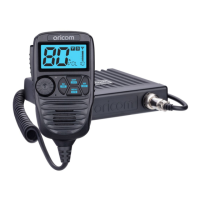
Do you have a question about the Oricom DTX4200X and is the answer not in the manual?
| Type | UHF CB Radio |
|---|---|
| Channels | 80 |
| Waterproof Rating | IP54 |
| Operating Voltage | 7.4V |
| Frequency Range | 476.4250 - 477.4125 MHz |
Contact information for Oricom support in Australia, including phone number and operating hours.
Contact information for Oricom support in New Zealand, including phone number and operating hours.
Lists the main features and capabilities of the Oricom DTX4200X radio.
Details available accessories for the Oricom DTX4200X radio.
Outlines critical safety precautions for operating the radio in various hazardous environments.
Explains the two possible wiring configurations for connecting the radio to vehicle power.
Discusses the importance of antenna selection for optimal radio performance.
Provides steps and guidelines for properly installing the radio's antenna.
Lists and describes optional accessories like microphone holders and external speakers.
Details the controls and indicators found on the front of the Oricom DTX4200X controller microphone.
Identifies the connectors and ports located on the rear of the Oricom DTX4200X transceiver.
Explains the various icons and indicators displayed on the radio's LCD screen.
Provides instructions on how to mount the UHF radio unit using the provided bracket.
Illustrates the connection points and installation layout for the radio components.
Instructions on how to power the Oricom DTX4200X radio on and off using the Jog Wheel.
Guide on adjusting the audio volume for comfortable reception.
Steps to navigate and select radio channels using the Jog Wheel.
How to adjust the squelch to filter out background noise.
Instructions for adjusting the volume of the secondary receiver.
Explains the function and usage of the Push-To-Talk button for transmitting.
How to use the scan feature to automatically search for active channels.
Describes how to scan channels stored in memory groups A, B, or C.
Explains how to scan channels using specific CTCSS or DCS tones for group communication.
Instructions for retrieving stored channels from memory using the MR button.
Steps for storing a selected channel into memory.
How to utilize the dual receive function and swap between main and sub channels.
How to enable or disable the Sub Receiver (SRX) function.
Overview of accessing and navigating the radio's menu system.
Explanation of the Repeater Access function and its use in duplex communication.
How to use CTCSS and DCS codes for selective communication.
Configuration for group tone scanning using CTCSS or DCS tones.
Options for customizing the LCD backlight color.
Adjusting the brightness level of the LCD backlight.
Steps to reset the radio to its default factory settings.
Explains the squelch tail feature and its effect on audio muting.
How to prevent transmitting on an occupied channel.
Describes the audible feedback provided when pressing buttons.
Option to enable or disable the display of a logo on the screen.
Explains the Transmit Power Indicator (TPI) and VSWR measurement.
Setting the pause duration after a signal is detected during scanning.
Configuring the automatic power-off timer for battery saving.
A list of Continuous Tone-Coded Squelch System (CTCSS) codes and their corresponding frequencies.
A table listing Digitally Coded Squelch (DCS) codes and their octal values.
Step-by-step guide on how to initiate a warranty claim in Australia.
Provides crucial details regarding product returns, data loss, and repair processes.
Contact details and operating hours for customer support in Australia.
Contact details and operating hours for customer support in New Zealand.